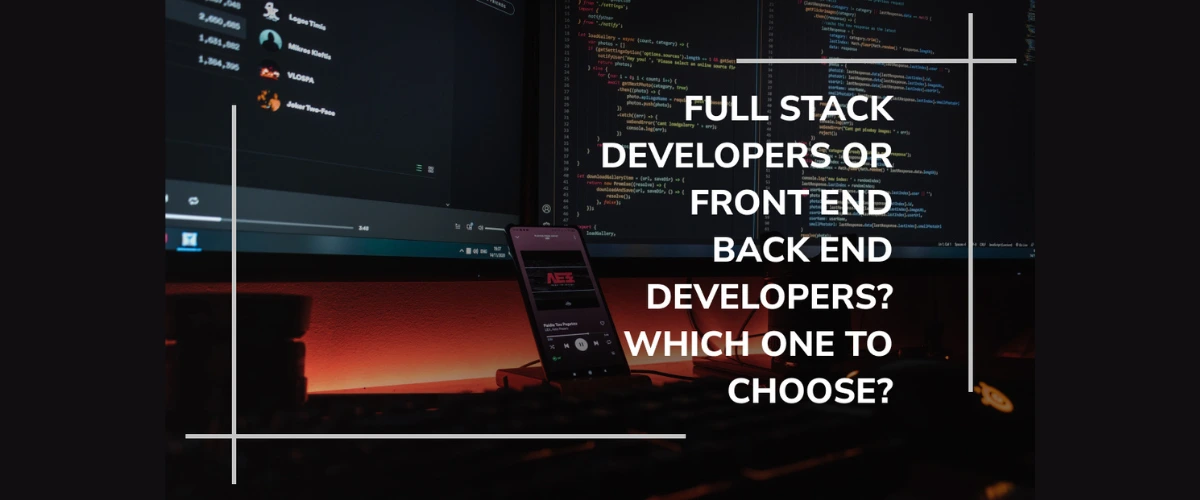Still confused? Then consider reading this article to get an overview, and by the end you will definitely come up with a conclusion.
Before jumping on to answer the question in the title, let us look at what defines them.
What are Full Stack Developers?
Full-stack developers are web developers or engineers who work on the front and back ends of websites or applications, which means they can handle projects including databases, build user-centric websites, and even help clients with project planning together.
Full-stack Web developers are familiar with HTML, CSS, JavaScript, and one or more server-side languages.
Most full-stack developers focus on some internal programming language, such as Ruby, PHP, or Python. However, some people, primarily if they work as developers for a long time, will use more than one language.
Some full-stack developers, especially in 2019, also learn project management, visual design, web design, or user interaction skills to complete their "stack" as needed.
With the blurring of the front-end and server-side boundaries, more and more developers are turning to the so-called "full-stack." Many employers (especially those that work with different types of websites) are looking for developers who know how to handle all parts of the website so that they can use the best tools to get the job done, whether it's a technical "user interface" or not or "back-end." Therefore, the emergence of a fully developed company is based on job requirements.
Contrary to what many people think, "full-stack" does not necessarily mean that developers will write all the code for the site themselves. Many full-stack Web developers spend most of their time at the beginning or end of website code.
But the point is that they have enough knowledge of all the code stacks that can be used anywhere. Some full-stack developers program the entire website, including front-end and back-end, but usually, only they are self-employed or the only developers working on the project.
In other words, the idea is that full-stack developers can cross-reference the entire technology "stack". Full stack developers provide a complete package.
About Front End Developers
Front-end developers create the visible parts of the website that users view and interact with within their web browsers.
The user interface (or Web or mobile application) is when the user sees and directly interacts with the user interface. Its structure language such as:
- HTML
- CSS
- JavaScript
HTML (hypertext markup language)
It's the backbone of the Internet; every website you visit is built with HTML. He is responsible for the entire structure and content. HTML5 is the current HTML version on the Web, although websites created with previous versions will still work in your browser.
CSS (Cascading Style Sheets)
It controls the appearance of HTML on the page. CSS defines colors, fonts, background images, and even the page's layout (using CSS, you can position HTML elements anywhere on the page, even if they are in a different order from the HTML file). CSS3 is the current version, an iteration of CSS on the Web. The above adds many features to things such as basic interactivity and animation.
Although the front-end is everything the user interacts with directly, the back-end is behind the scenes, which has some advantages compared to the project-specific front-end technology.
These include:
- PHP
- Ruby
- Python
A business note
You may not see many job postings saying that the company is looking for "internal developers." Instead, you will find lists looking for Ruby or PHP developers, etc., because the actual programming language that the developer knows is the key to a particular job.
Today's list of things that can be done with server-side languages that cannot be done with JavaScript is much narrower than in the past. One significant difference: Most content management systems are based on internal programming, for example, languages, like many large and complex Web applications. In some cases, JavaScript may experience performance issues (for example, it becomes slow or even problematic). So, while you can now use JS to build almost anything you can think of, sometimes there are even better solutions. Studying the code will teach you how to find the best solution to a particular problem, and sometimes this means using internal language.
Backend developers usually work with front-end developers to make their code work on the site or application design.
Conclusion
As you can already see, the skills that each of them acquires are different. But you must have also noticed that the front-end and back-end developers have specific skills or certain methods to work in, but full stack developers are familiar with all the aspects that the other two are, and they have their skills. Apart from this, full-stack developers are in demand because they are considered 'all-rounders.' So, you have your answer there. If you want to hire, then it has to be full-stack developers.


Let's Discuss Your Idea!
Whether you have a question for our team, want to chat about your project ideas, or are curious about our expertise, please send us your request using the form below.
Contact Info
Our contacts
Thank You!
We will respond to you within 24 hours.